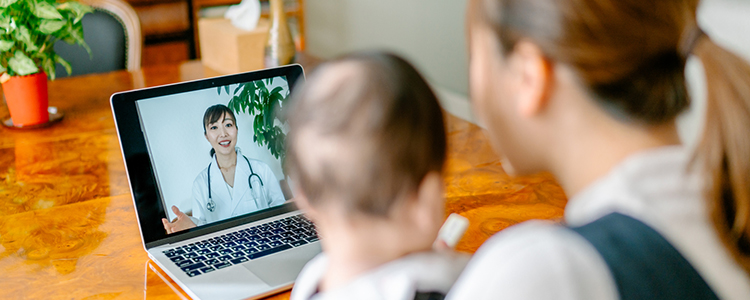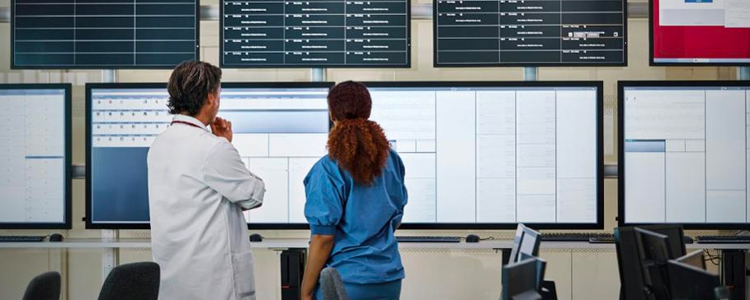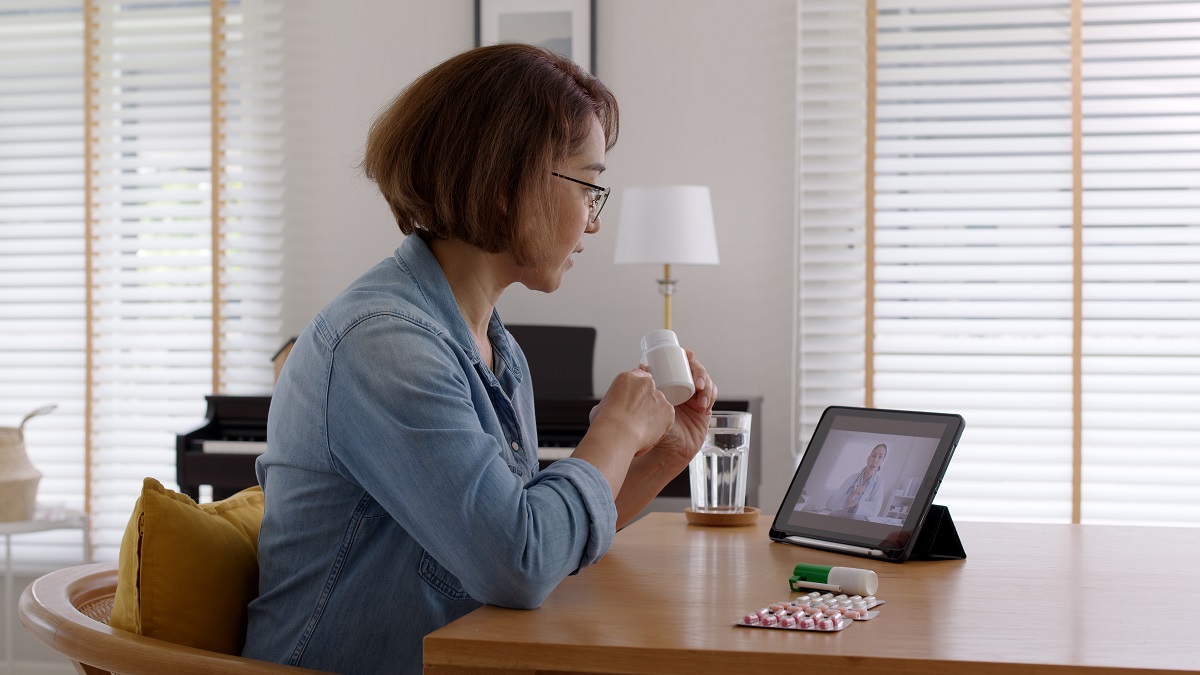- For SME and Groups
- For Individuals
Group Health Insurance
About Cigna Healthcare
Telemedicine Singapore: A Virtual Clinic
Telemedicine in Singapore offered by the Cigna Virtual Clinic
Telemedicine: Tapping into existing solutions for emerging problems
We have received overwhelming responses since the launch of our free COVID-19 Doctor’s Advisory Services. Our clients often want to know more about how telemedicine can support them, so we will be sharing more knowledge today by taking a deep dive into how telemedicine works.

What is Telemedicine?
Telemedicine is defined by the World Health Organisation as the “delivery of health care services, where patients and providers are separated by distance”3. It involves the use of telecommunications and virtual technology to deliver health care outside of traditional health care facilities4, such as mobile apps or video chat.
There are 3 different modes of telemedicine5 that encompass its many aspects. They are as follow:
- Clinician to clinician: More common in radiology, where healthcare professionals can share analysis and radiological images via email
- Clinician to patient: Where patients can seek diagnosis and medication for common illnesses via the internet, use of an app, a phone call or a video chat
- Patient to mobile health technology: Patients can track their own health, vitals, diet and physical activity via use of apps on their smartphones or even wearable monitors like a Fitbit. The information can also be transmitted to clinics and clinicians for further health monitoring.
In this article, we will be focusing on the second - clinician to patient telemedicine.

How Does Telemedicine Work?
Simply put, telemedicine allowsthe patient to seek medical treatment via the use of the internet or mobile smartphone apps, instead of having to physically travel to the clinic. The patient interacts with the doctor in real time via a voice or video chat, much like a physical consultation. This can be extremely useful and efficient, as it allows for the easy exchange of information.
In this sense, telemedicine consultations enable physicians to understand and diagnose the patient’s condition as they might in person, while the patient is free to clarify any queries or worries they might have. After the consultation, prescriptions can be delivered to a nearby pharmacy for collection, or even directly to the patient’s doorstep. This ensures that the patient receives exactly the amount of medication they require to avoidover-prescription. Likewise, any medical certificates or specialist referral memos are also sent electronically to the patient.
With these benefits in mind, it is undeniable that telemedicine does have certain advantages over physical consultations. Teleconsultations tend to be more time-saving than physical ones. In fact, the Cigna Virtual Clinic’s average waiting time is less than 5 minutes, as compared to the longer waiting times at clinics. Teleconsultations also allow the patient to see the doctor in the comfort of their own home. This affords them more time to rest and recuperate, while not having to go through the ordeal of travelling to seek medical help.
For other longer-term conditions that require regular check-ups, the patient can conveniently submit their medical data through an app or via the internet. This information is then stored in a secure database before being transmitted to the physician for analysis in their own time. After which, the physician will respond to the patient via the same platform for greater ease and accessibility.

Why is Telemedicine Important?
The COVID-19 (coronavirus) pandemic has put a huge strain on our physical healthcare system, with hospitals rapidly filling up and our healthcare workers being put under increasing strain. There is a need to reduce our dependence on the physical healthcare system to prevent it from being overloaded.
Telemedicine allows doctors to see patients more efficiently, especially for non-urgent cases. Other issues like physical check-ups can be also set aside to prioritise more time to urgent cases, as the data uploaded from the patient is stored and can be accessed any time after. All this allows healthcare professionals to be able to better manage their time and resources to deal with more pressing cases.
In view of the current situation, social distancing has become a norm in our daily lives as a measure to curb the spread of the virus. Telemedicine complements social distancing practices as it allows patients to remotely access healthcare services without having to leave their house. This greatly reduces the patients’ chances of being exposed to the virus, giving them a greater opportunity to keep themselves and their loved ones safe.

How Can Cigna Virtual Clinic (CVC) Telemedicine Help?
Our telemedicine solution is the Cigna Virtual Clinic (CVC), partnered with Doctor Anywhere. It is a platform that utilises technology to deliver quality medical care wherever and whenever it is needed. On its app, users can video consult a licensed practicing doctor for non-urgent conditions within mere minutes, and get the necessary medications delivered to their doorsteps. The following are its 6 core pillars:
- Video consult a locally licensed practicing doctor, who will be able to diagnose and treat common illnesses, prescribe medications, and issue medical certificates or referral letters
- Medication delivery for common, non-urgent conditions, which will be packaged and safely delivered to your doorstep within 3 hours
- Medical documents issued by the doctors, including receipts, consultation history notes, and health screening reports, are easily accessible in-App, anytime
- Travel health allows you to get relevant travel health advice and medication before your trips, as well as video consult doctors for medical advice when you are overseas
- Chronic disease management is a comprehensive programme that includes video consultations, follow-ups and medical delivery so that you can manage your condition without having to make multiple trips to the clinic
- Health content hub provides reliable health tips, insights and articles, to help you improve your health amidst the hustle and bustle of modern-day life
With these services, the CVC can ensure that quality healthcare for non-urgent conditions is not compromised, while also helping to offload some of the burden from our currently overloaded healthcare sector. Cigna’s telemedicine solution is therefore able to provide a more convenient, efficient, and cashless healthcare experience.

What are Some Challenges Facing Telemedicine?
Despite its benefits, telemedicine solutions still face some significant obstacles in terms of uptake. For one, telemedicine has often been overlooked and under-adopted by both patients and healthcare providers. Singapore’s telemedicine adoption rate amongst healthcare professionals, in particular, currently stands at 68%, a far cry from China’s and Saudi Arabia’s rates of 89% and 75% respectively6.
For patients, telemedicine is much more widely adopted by millennials and the subsequent generations, though this is less so for older generations and the less educated7. In fact, only 27% of local patients stated that they would prefer remote digital consultations with their doctors for non-urgent care, indicating that Singapore still has quite a way to go in terms of telemedicine education before there can be more widespread acceptance8.
One of the biggest contributing factors for the lack of telemedicine adoption is perhaps the scepticism of online diagnoses. The concern that teleconsultations may not be able to accurately diagnose conditions is an understandable one. After all, the utilisation of such technology means that we are no longer able to rely on the full physical examinations that we are used to with physical clinic visits.
However, it is important to note that telemedicine is not meant to fully replace the latter. The doctors on these platforms are trained and well-aware of the limitations of technology. Nonetheless, they are still able to make credible diagnoses via teleconsultations with the patients’ description of signs and symptoms, along with access to patient medical history. Technology can further inform the doctors’ examination in some cases, as phone cameras allow them to examine surface conditions, such as wounds, swelling, and skin appearance. When it comes to cases that require more thorough checks such as respiratory and/or abdominal examinations, the patient will be directed to a physical clinic instead to ensure that they get the care that they need.

What is the future of Telemedicine?
Such challenges, however, can also be seen as opportunities in disguise. Earlier this year in 2020, Singapore’s Ministry of Health (MOH) revealed that they will be working towards improving patient engagement and education on the benefits and limitations of telemedicine and telemedicine. Greater government support on such matters can help patients make more informed decisions when it comes to their healthcare choices, and even encourage greater telemedicine acceptance in the long run.
It is also plausible that as more social distancing practices come into play, that people will likely become more aware of telemedicine options and adopt it as a viable alternative to physical doctor visits for non-urgent care. We are encouraged by the growth of acceptance in telemedicine demands where the following are some of our recent observations for CVC:
- There was a 78% membership growth in Q1 2020, as compared to Q4 2019, indicating that more and more clients are adding the telemedicine feature to their plan designs
- We had a 186% registration surge in Q1 2020, as compared to the last quarter, which can be attributed to membership growth as well as demand created by the COVID-19 pandemic
- Of our registered members, 50% have used the tele-consult service at least once
- We also observed more than 80% increase in tele-consult usage in this quarter as compared to pre-COVID-19
Our telemedicine partner, Doctor Anywhere, has noted that more users and doctors have signed up to use the platform since the end of January 2020, with the total number of users more than doubling .Along with Doctor Anywhere also having raised S$38.4 million in hopes of a regional expansion, the future of telemedicine certainly seems bright as of right now10.
Get a Quote Today
Let our consultants prepare and arrange a customised group health insurance plan that best meets your needs.
Over to you – how you can help?
With the current state of affairs, it is our responsibility as employers to take care of the health and welfare of our employees. At the same time, we also have to keep in line with the strict measures set by the Singapore government, including social distancing practices and compulsory telecommuting for non-essential businesses. Telemedicine is one possible option that we can consider as a way to prioritise your employees’ health, while also helping to lessen the healthcare sector’s workload by complying to the measures set by the Singapore government. For more information, contact us here to find out more on the CVC and what else you can do for your company in this time of need.
Sources:
1. World Health Organisation. (2020). Coronavirus disease (COVID-19) Pandemic.
2.Wilson, J., & Parra, A. (2020). 'We are collapsing': Virus pummels medics in Spain and Italy. ABC News.
3. World Health Organisation. (2020). Telemedicine - Global Health Observatory (GHO) data.
4. World Health Organisation. (2020). Telemedicine - Health and sustainable development.
5. Tuckson, R., Edmunds, M., & Hodgkins, M. (2017). Telemedicine. New England Journal Of Medicine, 377(16), 1585-1592. doi: 10.1056/nejmsr1503323
6. Kurohi, R. (2019). Singapore lags behind China and Saudi Arabia in use of AI for clinical diagnosis and telemedicine, says survey. The Straits Times.
7. Cigna Global Wellbeing Solutions. (2019). Telemedicine: The clinical perspective on the role of Telemedicine within modern healthcare delivery.
8. Kurohi, R. (2019). Singapore lags behind China and Saudi Arabia in use of AI for clinical diagnosis and telemedicine, says survey. The Straits Times.
9. The Straits Times. (2020). Telemedicine start-up Doctor Anywhere raises $38.4m for regional expansion.
10. The Straits Times. (2020). Telemedicine start-up Doctor Anywhere raises $38.4m for regional expansion.
Related articles
Contact Us
Popular Links
Resources
Connect with us
© Cigna Healthcare. All rights reserved.
Cigna Europe Insurance Company S.A.-N.V. Singapore Branch (Registration Number: T10FC0145E), is a foreign branch of Cigna Europe Insurance Company S.A.-N.V., registered in Belgium with limited liability, with its registered office at 152 Beach Road, #33-05/06 The Gateway East, Singapore 189721.
The Cigna Healthcare name, logo, and other Cigna Healthcare marks are owned by The Cigna Group Intellectual Property, Inc. licensed for use by Cigna Corporation and its operating subsidiaries. All products and services are provided by or through such operating subsidiaries, and not by Cigna Corporation. Such operating subsidiaries include Cigna Europe Insurance Company S.A.-N.V. Singapore Branch.

